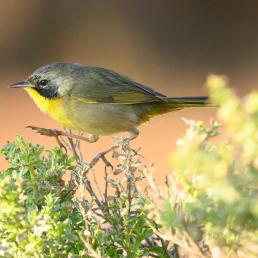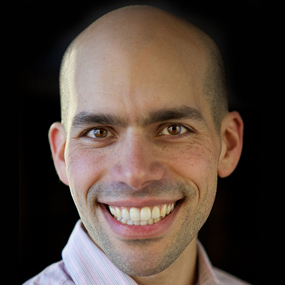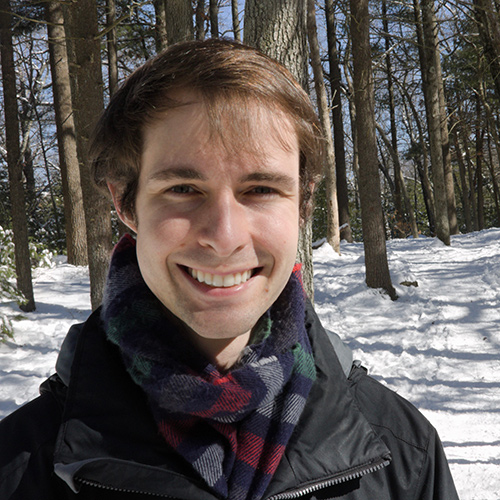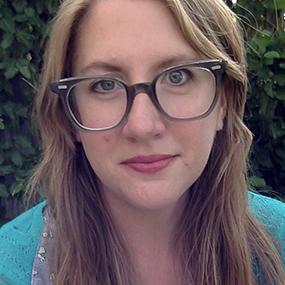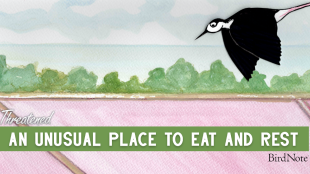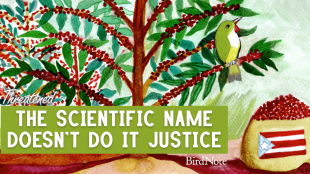

Join BirdNote tomorrow, November 30th!
Illustrator David Sibley and actor H. Jon Benjamin will face off in the bird illustration battle of the century during BirdNote's Year-end Celebration and Auction!
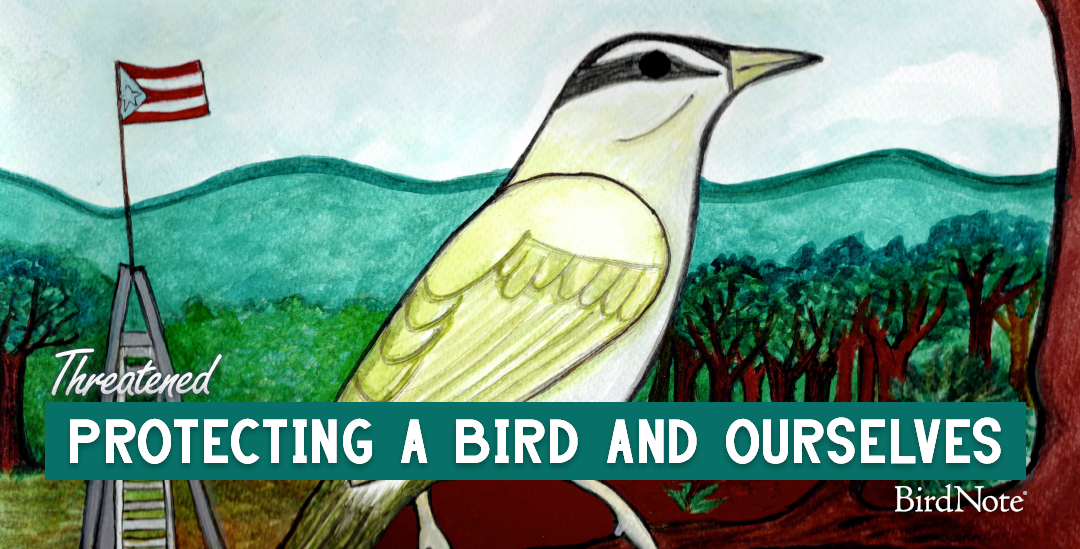
How do you organize a group of people to protect a bird from powerful forces? The Julián Chiví, or Black-whiskered Vireo, reveals a story of a community banding together to save a species, its environment, and ultimately, the people themselves. The organizers in Puerto Rico decided to go beyond just presenting alarming facts—and their strategy worked.
Listen to this episode in Spanish here.
Ari Daniel: BirdNote Presents.
[Echoing Wingflaps SFX]
[Music starts: Ay, cucu - Viento de agua]
Ari Daniel: Today on Threatened, we've got the story of a small bird and how it became a symbol of environmental protection in Puerto Rico. It’s called the Julián Chiví, or Black-whiskered Vireo, and it was saved by one community standing up against some powerful forces. I’m Ari Daniel, and this story comes to us from Producer Mariana Reyes.
[Music fades: Ay, cucu - Viento de agua]
Mariana Reyes: We actually have a saying in Puerto Rico that is relevant to this story and to birds. And it is: "Cada guaraguao tiene su pitirre", or "Every hawk has its kingbird".
Ari Daniel: Oh interesting. What does that mean exactly?
Mariana Reyes: Well, the Guaraguao is a Red-tailed Hawk and most birds are afraid of it, except for the small Pitirre or Gray Kingbird. It is kind of like the Bible story of David and Goliath, where no enemy is too big.
Ari Daniel: Okay, I see. But how does that connect to the story of the Julián Chiví?
Mariana Reyes: In this story, the hawk is a mining company. And the small birds? They are the people from a place called Adjuntas. The Julián Chiví itself will show up later in their efforts.
[Adventurous guitar music starts: Idle ways - Blue dot sessions]
Adjuntas, is a mountainous town at the center of the island of Puerto Rico. Back in the eighties, the nearby mountains were full of valuable copper, gold and silver.
At the time, mining companies filed for permits to extract the copper. It was 1980. The government was willing to approve the proposal for open-pit mining projects in an area of 37,000 acres of land in the municipalities of Adjuntas, Jayuya, Utuado and Lares. The project would have destroyed the flora and fauna of a large ecosystem, impacting local water supplies and farms. Thousands of families were at risk of losing their homes.
[Guitar music fades]
Ari Daniel: Extracting resources like this has profound consequences for land and water. I mean, people around the world struggle with this. With how to keep this activity out of their communities and usually the companies with big money win. So what did these families do?
Mariana Reyes: Well, there was a couple who led the struggle. That was Tinti Deyá and Alexis Massol. Alexis is a civil engineer and grassroots community leader. For more than 40 years, he has been on the forefront of the environmental justice movement in Puerto Rico.
He is an inspiration to many people, including me. I talked to him at Casa Pueblo in Adjuntas over coffee. Alexis shared how in the eighties the couple first tried to organize their community.
Alexis Massol: Y nosotros de esa no sabíamos qué hacer y celebramos una primera jornada anti minera y después de invitar a medio país, vino más que una persona.
Mariana Reyes: What Alexis is saying is that even though Tinti and him invited people from around the island to protest with them in Adjuntas, only one person showed up. One.
Alexis Massol: Eso se convirtió en un reto.
Mariana Reyes: But instead of giving up, they took it on as a challenge.
[Music starts: Base Camp - Blue dot sessions]
At first, the approach was straight to the point. They wanted people to know what was going to happen and the devastating effects the open-pit mining project would have on their families from several perspectives: the environment, the economy, and their health. The facts presented were alarming but the approach obviously wasn't working. So Tinti and Alexis had to change course.
Alexis Massol: Y decidimos organizarnos desde la perspectiva comunitaria, con la gente del pueblo, con las diferencias, porque en las diferencias está la unidad.
Y de ahí nace una ecuación que es, la podemos describir como ciencia que nos da el conocimiento para rebatir los argumentos de la minería, más cultura que nos da la identidad y el orgullo de ser puertorriqueñas y puertorriqueños, más comunidad.
[Music fades]
Ari: Mariana, it sounds like they were really trying to, kind of, organize themselves around their community and get that perspective from their community and seek unity that way?
Mariana Reyes: Yes. Besides the science, they added culture and community. That meant inviting artists to join them in protests, performances and other events.
[Sound of a protest]
Protests in Puerto Rico may seem joyful to other people. Live music is usually part of such events. And so is dancing and singing while people march.
[A band playing during a protest]
The early efforts to protect the forest at Adjuntas picked up this tradition and added a cultural element to their strategy.
From then on, there was live music, storytelling and workshops at all their events. The group of organizers eventually established themselves as Casa Pueblo which in English means, literally “People’s House”, and led a long journey of 15 years against the open-pit mining project.
[Music starts: Borough - Blue dot sessions]
Alexis Massol: Así que una comunidad con orgullo y con conocimiento puede hacer transformaciones.
Mariana Reyes: Casa Pueblo learned by doing, that scientific knowledge and cultural pride can transform communities.
In 1995, Pedro Rossello, the then-governor of Puerto Rico signed a law banning open-pit mining, thanks to the movement led by Casa Pueblo. After 15 years of organizing, the forest in Adjuntas once targeted for mining became the only natural resource in Puerto Rico to be managed by a community group. And it was renamed Bosque del Pueblo, or the People's Forest.
[Music Fades Out]
Alexis Massol: Tan pronto obtuvimos la victoria nos volvimos a preguntar: ¿hacia dónde vamos? ¿Cuál es el país alternativo que queremos? Porque el país alternativo hay que construirlo. Decidimos evolucionar de la protesta, sin descartarla, a la alternativa sostenible. A la resistencia, que es fundamental en este país, le añadimos alternativas. Resistencia más alternativas es igual al Bosque del Pueblo.
Mariana Reyes: Casa Pueblo won the fight and took over the management of the forest, but they didn’t do so without some introspection. They wanted to build a new country, a new way of living in community. Building a sustainable alternative. As Alexis, just said, going from protesting to creating that alternative. They started to really look and listen to the forests and that is how they noticed the sound of the Julián Chiví.
[Julián Chiví calls]
Ideas on how to accomplish the transformation they were aiming for would come from those living high up in the forest that surrounds Casa Pueblo.
Alexis Massol: Cuando nosotros logramos el Bosque del Pueblo, que empezamos a hacer inventario de flora y fauna, empezó a llegar como en febrero un pajarito que cantaba. Y durante todo el año, de septiembre a febrero, no se escuchaba. Y entonces, buscamos los herpetólogos, los micólogos, los especialistas en aves: ¿oye, cómo se llama esa ave? Se llama el Julián Chiví. Nos pareció tan interesante que empezamos a celebrar un festival todos los años del recibimiento del Julián Chiví.
Mariana Reyes: The Julián Chiví is a small olive-gray bird, with a short, thick beak and distinctive black lines on the sides of its throat. It comes to Puerto Rico every year and breeds in the People's Forest, among other places.
Alexis named it Puerto Rico’s ambassador to the rest of Latin America because the bird flies every year from Puerto Rico to South America, but they are born here. This is a relevant metaphor given the fact that Puerto Rican people have no actual embassies anywhere.
Alexis Massol: Yo creo que no teniendo nosotros embajadores ni teniendo relaciones con otros países, pues el Julián Chiví resuelve el problema político de Puerto Rico porque representa a todos los puertorriqueños en toda Latinoamérica.
Mariana Reyes: The Julián Chiví became a symbol for the people of Adjuntas. In the late nineties, Casa Pueblo started celebrating a yearly festival to welcome the bird. They offered educational and cultural programming.
[Julián Chiví song at Casa Pueblo by Danny Rivera]
They even have their own radio station. And their theme song is a tribute to the Julián Chiví.
[Casa Pueblo radio excerpt + theme song]
Mariana Reyes: The song is a welcome to the Julian Chiví. But it also talks about friendship and getting to know each other.
Alexis Massol: En el recibimiento lo primero que tratamos de escucharlo y después que tú lo escuchas pues te sientes bien feliz. Pero la segunda felicidad es conocerlo. Hacer la amistad, abrazarnos, mirarnos…
Mariana Reyes: And of course the Julián Chiví sings as well. At the festival the first thing that they try to do is listen to it and feel happiness for its return and also for each other.
Y finalmente hacíamos una ceremonia de recibimiento donde se hablaba del ave y de que emigra, que era un embajador puertorriqueño en la tierra latinoamericana. Nos acostábamos sobre la tierra, hacíamos una oración sobre Julián Chiví, lo que pensábamos, después escribía… Era, era bien místico.
[Music starts: Threatened inspiration theme]
Ari: Wow it’s really something, I mean like this Julian Chiví becomes kind of like the anthem, the mascot, the ambassador as Alexis points out, of their whole effort.
Mariana: Yes and he also mentions that in this yearly effort to receive the Julian Chiví, they will just stay still and listen to it, and then they will also lay down on the grass and think about the bird, and write about whatever came to their mind. So it was a very specific process that they went through with their relationship to the Julian Chiví.
Ari: And you know, this movement to protect the forest and, as you said Mariana, combining knowledge about science with cultural pride has had profound consequences for the region and the people living there. More on that after the break.
[Music fades]
[MIDROLL]
[Funky upright bass music starts: Lumber Down]
Ari Daniel: So, Mariana, the movement led by Alexis and Casa Pueblo, it sounds remarkably transformative. And I'm wondering, how do you think standing up to the mining company and then winning against the company… How did it change the community? What's been the impact that Casa Pueblo has had on the community?
[Music Fades Out]
Mariana Reyes: Well, if we are literal about it, the first thing they did was to preserve a place and its people along with the Julián Chiví. A community is still standing because it was able to stop a mining project.
Later on, Casa Pueblo turned into a place where another way of living is possible, another kind of life. The best example is a campaign in favor of solar power. In recent years, they have put in a lot of effort and resources to create a movement and a shift towards solar energy in Adjuntas.
[Hopeful music starts: Lahaina]
When hurricanes Irma and María hit in 2017, Puerto Rico was left in the dark for months. You might not realize how much you need electricity for many activities until you don't have it for days, weeks, or months. It is truly life changing.
This organization took matters into their own hands and started a solar insurgency. Casa Pueblo transformed the center of their town into a solar-powered area. They are leading the way for other organizations and communities that learned the hard way that we must be ready for extreme weather events and their consequences.
Alexis Massol: Tres meses antes de María, en julio del 2017, nosotros logramos alcanzar el cien por ciento de la, de la energía de Casa Pueblo. Nos hicimos independientes y tres meses después viene María. Se fue la luz por cinco meses en Adjuntas menos en Casa Pueblo. Y Casa Pueblo se convierte en un oasis energético.
[Music Fades Out]
Ari Daniel: That’s really incredible to have that kind of self-sufficiency, that Casa Pueblo’s facility was able to get entirely off the grid just three months before the hurricanes of 2017. So after the storm their organization became an oasis for the people that needed to recharge electronics and medical devices, cook their meals, and rest. To survive, really.
Mariana Reyes: Yes, exactly. When these environmental threats are just an idea or an abstraction it is not easy to have people go out of their way and join efforts to solve these issues.
But having a threat that is tangible, like needing to turn on the lights in your house, changes your mindset because you need to solve the issue soon.
Of course, there are always setbacks. In 2014, a fire broke out in the People's Forest and burned a large part of it. Alexis says that the fire was caused by arson.
[Guitar music starts: Kilkerrin]
Alexis Massol: De hecho, una vez le pegaron fuego al bosque y en un solo día sembramos más de mil árboles. Y la gente llegaba allí y decía "Este bosque es mío" y sembraba un árbol. "Este bosque es mío". Nosotros interpretamos eso como un territorio social conquistado.
Ari Daniel: So the community showed up for the forest after the fire too.
Mariana Reyes: Yes! They replanted 1,000 trees. And as they did it, they said "This forest is mine."So now they feel a sense of ownership of the forest that they didn't feel, for example, before the fight against the mining companies in the eighties.
[Music Fades Out]
The fire moved people to act in different ways and generated creative responses like the one from Tere Marichal. Tere is an actress, a storyteller, and a beloved children’s entertainer.
Tere Marichal: I’m Tere Marichal from Puerto Rico and, in 2014, when the fire destroyed the forest, I was very sad. And when I have a very strong feeling about something, I always create something because, because I understand that I live in a colony. And when you live in a colony, like Puerto Rico, you learn to create a lot, because there are so many things that happens in our history and our society that if you don't use, eh, your courage to create something, you get mad. So I decided to write a story about the Julián Chiví and the story was called “My House is on Fire”.
Mariana Reyes: "My House is on Fire" tells the story of a Julian Chivi arriving to the Bosque del Pueblo. Everyone in the forest was happy. Well, not everyone. There were some insects that were very worried because the Julian Chiví loves to eat insects! A fire breaks out in the forest and the birds and insects plant trees and spread seeds afterwards, to rebuild it.
When I heard Tere's story I was left with the idea that building community is always an ongoing process.
[Sound of music being played at a festival]
Casa Pueblo’s mission has a strong educational component that led them to create the festival in which the community welcomes the Julián Chiví when it returns every year.
Alexis Massol: Y esa es la herramienta nuestra: la ciencia, la cultura y comunidad. Y la cultura nuestra es fundamental. Y cuando, eh, protegiendo el ambiente. Y protegiendo ese ambiente estuvimos 15 años hasta que logramos la victoria y celebramos, 15 años después donde había uno habían 10,000.
Mariana Reyes: Alexis mentioned that it took 15 years to go from an event with only one person in attendance to having more than 10,000 people celebrating the people’s triumph. The Julián Chiví's migrant nature has also been linked to the constant flow of Puerto Rican people to the U.S. and back.
Alexis Massol: Y resulta que una vez nos invitaron a una escuela a hacer cuentecitos y le hice un cuento del Julián Chiví, esto que estoy hablando.
Mariana Reyes: Alexis is saying that he was invited to a school to read stories to the kids.
Alexis Massol: Y le pregunté por qué el pajarito regresa en febrero. Y una nena "Mister, yo. Mister yo". Y dice, "Porque ese pajarito ama mucho a Puerto Rico". Y por qué tú lo sabes. Y dice, "Sí, porque regresa en febrero y febrero es el mes del amor".
Mariana Reyes: And one girl mentioned that the bird came back every February because it loves Puerto Rico and February is the month of love.
Alexis Massol: Entonces otros nenes, "Es como, es como mi papá". ¿Y cómo es tu papá mi papá? Y dice, "Mi papá se va todos los años a coger tomates a New Jersey, pero siempre regresa como el Julián Chiví porque ama a su familia”.
Mariana Reyes: A boy compared it to his father that goes back to the states every year to work in seasonal agriculture.
Alexis Massol: Entonces otra nena dijo, "Don Alexis, yo, yo. Mira, yo sé por qué el Julián Chiví siempre regresa". ¿Y por qué? Me dijo, "Porque él viene a tener sus crías con ciudadanía puertorriqueña".
Mariana Reyes: Finally, another student suggests that the Julián Chiví comes back because it has Puerto Rican citizenship.
[Julián Chiví calls]
Ari Daniel: It’s just awesome to have this welcome back party for the Julián Chiví become part of the fabric of the community. To say, like, you're welcome back here to Adjuntas, to Puerto Rico.
[Reflective, thoughtful music starts]
Mariana Reyes: Yes, exactly. The Julián Chiví festival is also a good excuse to gather people, play music and spend time with each other.
That is the case in my own community in Santurce, a district in the capital city of San Juan. I have seen that when you add a cultural element like a festival to your organizing strategy, people tend to be more open to getting together to talk about problems and brainstorm solutions.
So Casa Pueblo's strategy is gathering people in a joyful and thoughtful way in order to stay in contact and aware of issues they have in common.
Ari Daniel: I love that because ultimately what they're trying to achieve is: they're trying to protect their community and trying to protect their surroundings. And in order to maybe do that most effectively you have to be in a spot where you're actively appreciating that community and your surroundings.
And it sounds like that's what they've captured by bringing people together. You know, not with the stated purpose of organizing, but it's that capturing that sense of community that they're able to leverage.
It seems like there was a kind of ripple effect that once the people of Adjuntas took responsibility for their forest and for protecting it, that it kind of continued to make waves and it continued to… It made a lasting difference. And that first win kind of instilled in them something that's really lasted for a long time.
[Music Fades Out]
Mariana Reyes: The influence of Casa Pueblo on various social movements in Puerto Rico is undeniable. Their success and longevity is unusual for a grassroots community initiative. This organization has been an inspiration to many, including me.
In 2015, the local public school in my community in Santurce was closed as a result of ongoing budget cuts. Over 600 public schools have been closed in Puerto Rico in the last decade. So we organized.
A group of neighbors got together and demanded that the school remain in the hands of the community. After five years of hard work, the school is now a community cultural center called La Goyco that serves the residents of the area. It is a historic building facing one of the busiest and most gentrified areas of San Juan.
[Music starts: Ay, cucu - Viento de agua]
We work every day to make the lives of our neighbors a little better. The center has become a cultural anchor where we gather to talk and work through our collective problems.
Our programming includes music concerts and workshops, film screenings and classes, psychotherapies, and a community garden where bird houses built by neighborhood kids attract hummingbirds every day.
[Music fades]
[Threatened theme fades up]
Ari Daniel: There are lots of ongoing fights in Puerto Rico: to protect resources, to create resilience. Next week we’re going to hear about a different kind of fight, one that centers around changing the name of a bird to accurately reflect its natural history. And, we’re not talking about its common name. We’re talking about its scientific name. The Latin one.
Adrienne Tossas: Todus mexicanus is the Puerto Rican Tody in English. But the scientific name is a mistake that comes from the 19th century.
Ari Daniel: That’s next week on Threatened.
This episode was produced by Mariana Reyes Anglero, Joanne Gil Rivera and me, Ari Daniel. It was edited by Caitlin Pierce of the Rough Cut Collective and Laura Marina Boria. It was sound designed and mixed by Leah Shaw Dameron. Fact-checking by Conor Gearin. Our theme song and original music were composed by Ian Coss, with additional music by Viento de Agua. Threatened is a production of BirdNote and overseen by Content Director Allison Wilson. You can find a transcript of this show and additional resources, BirdNote’s other podcasts, and much more at BirdNote dot org. Thanks for listening. See you next time.
